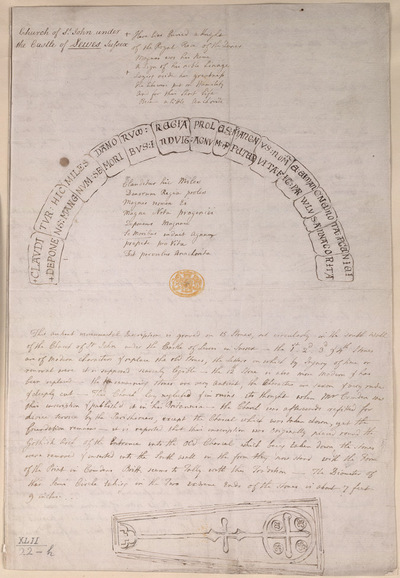Javascript must be enabled to continue!
Monumental inscription from Church of St John under the Castle of Lewes
View through Europeana Collections
Historian William Camden translated the
inscription as follows: "Here lies a soldier good, Of Danish royal
blood. Magnus was once his name, And like it great his fame. His
greatness laid aside, An humbler life he tried, Exchang'd for
ruffian's prize, An hermit's simple guise."The note accompanying
the sketch records: "This antient monumental inscription in graved
on 15 stones, set circularly in the south wall o fthe Church of St
John under the Castle of Lewes in Sussex - the 1st, 2d, 3d &
4th stones are of modern characters & replace the old stones,
the letters on which by injury of time or removal were it is
supposed scarcely legible - the 12th stone is also more modern
& has been replaced - the ten remaining stones are very
antient, the characters are Saxon & very rude & deeply
cut - This Church lay neglected & in ruins its thought when
Mr Camden saw this inscription & published it in his
Britannia - the Church was afterward refitted for divine service by
the Parishioners, except the chancel which was taken down, yet the
foundations remains - it is reported that this inscription was
originally placed round the Gothick Arch of the Entrance into the
Old Chancel which being taken down, the stones were removed &
inserted into the South Wall in the form they now stand with the
form of the print in Camden's Britt. seems to tally with this
tradition - The Diameter of the Semi Circle taking the two extreme
ends of the stones is about 7 feet."
The British Library
Title: Monumental inscription from Church of St John under the
Castle of Lewes
Description:
Historian William Camden translated the
inscription as follows: "Here lies a soldier good, Of Danish royal
blood.
Magnus was once his name, And like it great his fame.
His
greatness laid aside, An humbler life he tried, Exchang'd for
ruffian's prize, An hermit's simple guise.
"The note accompanying
the sketch records: "This antient monumental inscription in graved
on 15 stones, set circularly in the south wall o fthe Church of St
John under the Castle of Lewes in Sussex - the 1st, 2d, 3d &
4th stones are of modern characters & replace the old stones,
the letters on which by injury of time or removal were it is
supposed scarcely legible - the 12th stone is also more modern
& has been replaced - the ten remaining stones are very
antient, the characters are Saxon & very rude & deeply
cut - This Church lay neglected & in ruins its thought when
Mr Camden saw this inscription & published it in his
Britannia - the Church was afterward refitted for divine service by
the Parishioners, except the chancel which was taken down, yet the
foundations remains - it is reported that this inscription was
originally placed round the Gothick Arch of the Entrance into the
Old Chancel which being taken down, the stones were removed &
inserted into the South Wall in the form they now stand with the
form of the print in Camden's Britt.
seems to tally with this
tradition - The Diameter of the Semi Circle taking the two extreme
ends of the stones is about 7 feet.
".
Related Results
Ruins of Wilton Castle belonging to Sir [Step] Fox
Bart.
Ruins of Wilton Castle belonging to Sir [Step] Fox
Bart.
Sketch of the ruins of Wilton Castle at near
Redcar. This is presumably the remains of a medieval building,
possibly a castle or fortified manor house. Langdale's Yorkshire
Diction...
Hackney Church
Hackney Church
This view of Hackney Church was taken from Pig
Well, one of several nearby wells known for the purity of their
water.In medieval times, the church had been dedicated to St
Augustin...
The Castle of the Pyrenees
The Castle of the Pyrenees
Belgian Surrealist René Magritte’s masterpiece The Castle of the Pyrenees was commissioned by the artist’s longtime friend, the international lawyer, poet, and author Harry Torczyn...
Deal Castle, Kent
Deal Castle, Kent
This is a plan of Deal Castle, the Tudor
artillery fort dating from around 1539. One of a chain of castles
along the south coast of England commission by Henry VIII to
protect the ...
painting (oil): ["Peasants Fleeing"] aka ["Witchcraft"]
painting (oil): ["Peasants Fleeing"] aka ["Witchcraft"]
"May have been a section of a larger painting; subject relating to witchcraft. Unsigned." [Register] "It is painted in grisaille and appears, from the way the panel is cut, to be t...
Castle in landscape
Castle in landscape
A watercolour painting of a Castle in landscape. It is drawn in pencil and is incribed Bow & Arrow Castle (Pensonslina Castle)? 14th July/67in ink. There are various other annotati...
painting (watercolour): ["Twilight-Stirling"]
painting (watercolour): ["Twilight-Stirling"]
Landscape with Stirling Castle looming high on a mountainside. The mountain and castle are in silhouette with a few yellow lights twinkling in the castle. In the foreground, a man ...
Recent Results
A Multidisciplinary Evasion of the Futuristic Goals of Technology and Marketing
A Multidisciplinary Evasion of the Futuristic Goals of Technology and Marketing
New technologies have revolutionized every aspect of human existence including the ways that firms make products and service to consumers.
Marketing has a long tradition of studyin...
Zircon U‐Pb Chronostratigraphy and Provenance of the Cycladic Blueschist Unit and the Nature of the Contact With the Cycladic Basement on Sikinos and Ios Islands, Greece
Zircon U‐Pb Chronostratigraphy and Provenance of the Cycladic Blueschist Unit and the Nature of the Contact With the Cycladic Basement on Sikinos and Ios Islands, Greece
AbstractSikinos and Ios Islands, located in the Southern Cyclades, represent part of a Cenozoic metamorphic core complex system that exposes subduction‐related metamorphic rocks in...
Les bains d'or de Caligula. Immensi aureorum acerui (Suétone, Cal. 42, 3)
Les bains d'or de Caligula. Immensi aureorum acerui (Suétone, Cal. 42, 3)
Julien Guey, «Les bains d'or» de Caligula, immensi aureorum acerui (Suétone, Cal, 42, 3), p. 443-446.
Il s'agit d'un sacrement «à l'égyptienne», le Pharaon é...











 Your session has timed out for security reasons.
Your session has timed out for security reasons.